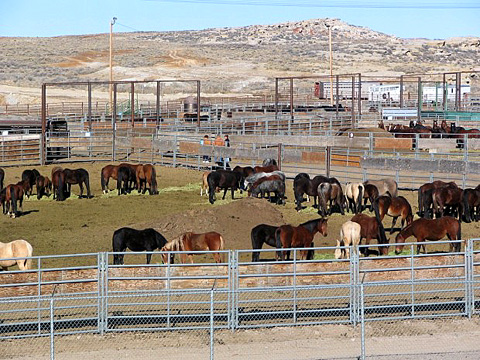
BLM Facts (as reported by the BLM) from the Associated Press – and a response at the end by a private citizen.
The U.S. Bureau of Land Management manages more than 245 million acres of federal land in 12 western states with about 30 million acres currently designated as horse management areas in 10 of those states under the authority of the Wild and Free-Roaming Horses and Burro Act of 1971 signed into law by President Nixon. BLM reports the following as of May 27:
10 STATES WITH WILD HORSES ON U.S. LANDS: Arizona, California, Colorado, Idaho, Montana, Nevada, New Mexico, Oregon, Utah and Wyoming.
POPULATION: About 33,000 horses currently roam the 10 states, roughly half of those in Nevada, with another 5,500 burros for a total of about 38,500 animals under the jurisdiction of the U.S. Bureau of Land Management. [NOTE by me: That’s 779 acres per horse/burro. Sure seems like one animal can exist on that much land]. The BLM maintains that’s about 12,000 more than the rangeland can sustain and plans to roundup most of those to get to the formal appropriate management level it has set for the current year at 26,600.
2010 ROUNDUPS: BLM removed 9,715 horse and 540 burros from the range in the 2010 fiscal year that ended last Sept. 30.
HOLDING FACILITIES: In addition to animals on the range, the BLM currently has 41,700 wild horses and burros in short-term corrals in the West (about 13,100) and long-term pastures in the Midwest (about 28,600).
BUDGET: The BLM spent $67 million on its wild horse and burro program for the 2010 fiscal year, about $37 million of that to house the animals in holding facilities after they’ve been removed from the range.
___________________________________________________________________________________________
And Marybeth Devlin in Florida disagrees with the BLM provided facts.
This news article references certain incorrect information about America’s wild horses and burros — but the errors were not the fault of the Associated Press. The AP’s innocent mistake was in citing Bureau of Land Management statistics. Congress, the courts, wildlife advocates, the media, and the public — all assume that BLM is providing accurate data regarding wild horse populations. Trusting that the data is valid, these parties rely on it, draw conclusions from it, even formulate land-use decisions based on it.
But the BLM data is false, distorted to show an “excess” of mustangs that does not exist. Independent analysis has shown that the 38,500 on-the-range figure is over-stated by more than double. Using BLM’s own data, birth-rate assumptions, and removal reports, C.R. MacDonald calculated that there could be — at most — only 17,893 mustangs left on the range as of February 28, 2011. Further, only adult horses and burros are supposed to be counted for purposes of determining “appropriate management levels.” Any newborn foals are not yet eligible for inclusion in the population data, as BLM is well aware. In actuality, there are at least 8,000 fewer mustangs than the sparse number that BLM allows and at least 20,500 fewer than BLM is reporting. You can get more information by clicking HERE.
